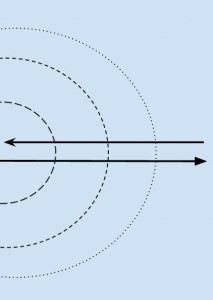 外部的作用:合上。由大到小。
外部的作用:合上。由大到小。
function of outside: harmonize, from large to small
内部的作用:发力。由小到大。
function of insde: issue force, from small to large
Translation of a lesson summary in chinese, please leave another translation or discuss what this lesson about
by admin2 on 2014/02/27
 外部的作用:合上。由大到小。
外部的作用:合上。由大到小。
function of outside: harmonize, from large to small
内部的作用:发力。由小到大。
function of insde: issue force, from small to large
Translation of a lesson summary in chinese, please leave another translation or discuss what this lesson about
Previous post: “1,2,3 interactions” Online Video Trailer
Next post: Milwaukee Blog

{ 9 comments… read them below or add one }
The outside needs to fill any gap between yourself and the opponent, so the gap goes from large to small. The inside (the power) needs to expand from small to large, while the outside doesn’t change anymore.
After reading this a few times I thought of it this way:
The outside neutralizes the opponent’s movements/force. You match the opponent’s large movement neutralizing it, making it small and thus creating a “bite”. Once this has been achieved the internal expands creating compression power and what appears to be a small movement results in large reaction in the opponent.
Another way to put it would be,
outside : in order to harmonize, we need to take out the space between ourselves and our opponent, first the physical space around the opponents structure (large) then the internal space (squeeze/compress opponents structure) small
inside : small force is multiplied/amplified as it moves correctly through the joints, if leaking is controlled joints act as one way transmitters of force like differential gears that create amplified power ratios (small to large)
many many criteria must be met in order for either of these things to happen……
Contact with opponent is outside, match his force by adjusting own body from outside to inside
Once there is harmony, to issue is indirect power from inside
From what I can understand, this principle when physically established and applied is what allows us to neutralise incoming strikes upon contact. Harmonising with the opponent bypasses their power and allows us access to their centre. Expanding our inside from small to large then allows us to “hit” the opponent’s centre without an impact force and with no local movement or power on our part at the contacting point(s).
Outside (5 heads) is big and deep inside (dantian) is small. Harmonized opponent’s force from outside and drawing all the power to dantian and switch power between kuas like U turn a car, issue force back to opponent. There is contraction, turn joints and expansion as in circle foundation exercise.
Hi Wilkin,
With your part where it says ‘match his force by adjusting own body ‘, I have a question. Is this matching creates a stale mate (equal but opposite energy – 1 pound against 1 pound) before disrupting it (the +1 part)?
Does this relate to the other adage where it says 4 ounce can move 1 pound? From how it sets out, the matching part indicates I will need at least one pound first to ‘match’ incoming force before I can disrupt it by adding an extra 4 ounce? Or am I mixing things/concepts wrongly?
David,
You are right. Matching is the key word here. It can be done with weight, speed, angle, and many many ways.
So at the very raw skill, it will look like ‘head on power against power’ because that is normally how we do a ‘match’, then later as skill in manipulation develops, other factors can be used to match such as weight etc. Thanks Master Chen.